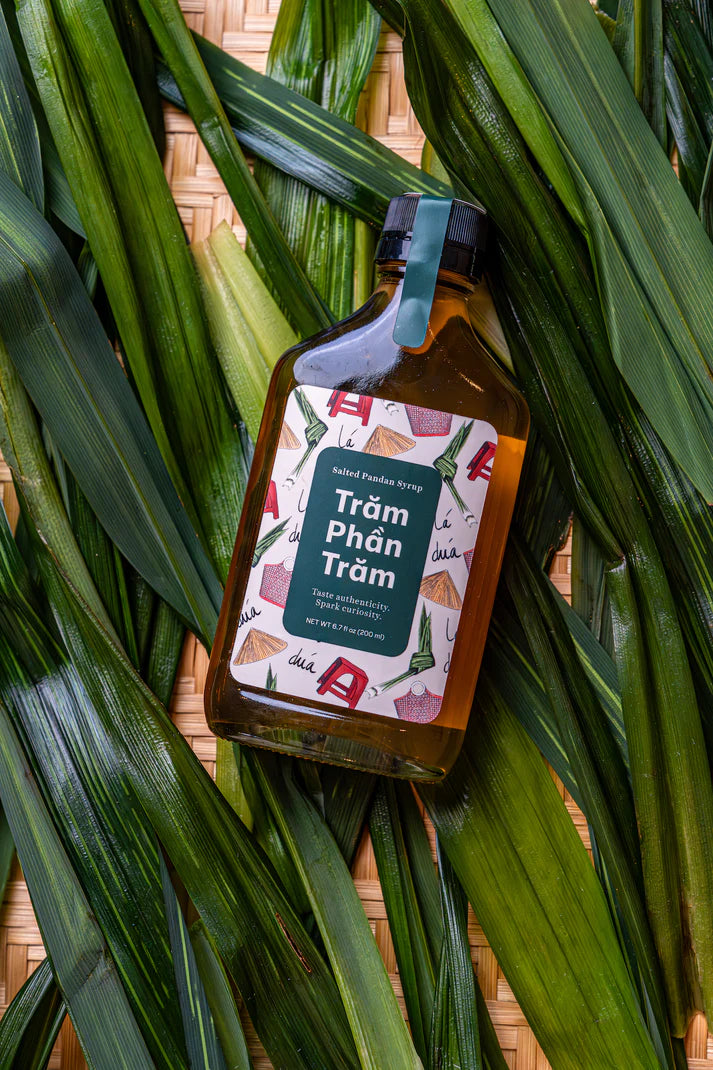Tram Phan Tram Salted Pandan Syrup (200ml)
Tram Phan Tram Salted Pandan Syrup (200ml)
Producer Notes by Thi Nguyen:
Pronounced [ cham-phun-cham ]
A Vietnamese phrase meaning 100% but also a slang term in Vietnamese meaning bottoms up.
Trăm Phần Trăm, a collection of Asian-inspired syrups that will transform your creations.
Each bottle captures the essence of Asian flavors and culture.
What is Pandan?
Pandan, scientifically known as Pandanus amaryllifolius, is a tropical plant widely celebrated in South and Southeast Asian cuisine for its exceptional flavor and aroma. Pandan leaves have a vibrant green color and a fragrant, floral scent.
Pandan's aromatic profile is likened to a grassy note, but without the earthiness typically associated with such scents. Pandan is sometimes referred to as "the Asian vanilla" or "vanilla of the East" due to its similarity in versatility and aroma. Personally, I find pandan's unique fragrance to be a delightful combination of nuttiness and subtle floral sweetness.
Pandan can be used fresh or dried and are commonly tied into knots or cut into strips before being added to various recipes. They are especially popular in South and Southeast Asian cuisines, including India, Sri Lanka, Thai, Indonesian, and Vietnamese cuisines.
Exploring the Versatility of Pandan
Pandan leaves indeed have a versatile role in Vietnamese cuisine. One popular application is in the creation of Bánh Bò Nướng, a classic Vietnamese honeycomb cake. To achieve the cake's vibrant green color, I remember my mom would blend the pandan leaves with water and the resulting liquid is strained and added to the batter. The infusion of pandan lends the cake its bright green color, complementing its distinct honeycomb texture and golden-brown crust.
Similarly to Malaysian and Indonesian cuisines, Vietnamese home cooks also utilize pandan leaves to add a subtle sweet fragrance to rice dishes. During the cooking process, the pandan leaves, often tied in knots, are placed in the rice pot, allowing the delightful aroma of pandan to infuse the rice, enhancing the overall dining experience.
While pandan is often associated with sweet dishes, it also has savory applications in India & Sri Lankan cuisine. There, it is primarily used as a savory component in curry dishes, adding a distinct flavor profile to the culinary creations of the region.
In Thailand, a globally beloved dish called Gai Hor Bai Toey, or pandan-wrapped chicken, showcases another way to harness the aromatic essence of pandan. The chicken is marinated and then wrapped in pandan leaves before being grilled or fried, infusing the meat with a delightful fragrance and subtle flavor.
Pandan in Cocktails
As someone who has grown up with pandan as a part of my culinary heritage, it's incredibly heartwarming to witness its growing presence in American cocktail bars. It's like a taste of home, a connection to my roots, right here in the U.S. To see my fellow bartenders, embrace the challenge of incorporating pandan's unique taste into their creations is truly inspiring.
What excites me the most is how versatile pandan can be in cocktails. Its nutty flavor and delicate floral notes can transport you to a tropical paradise, evoking memories of vibrant flavors of Southeast Asia. When combined with ingredients like pineapple, citrus, and rum, pandan creates a symphony of flavors that dances on your palate. But it doesn't stop there. Pandan has been incorporated into classic cocktails such as the Negroni and Old-Fashioned, offering new dimensions to these beloved favorites.
For me, seeing pandan in American cocktail bars is more than just a trend. It represents a cultural exchange, a bridge between my heritage and the adopted home that I've come to love. It's a reminder that flavors and traditions can transcend borders and bring people together in a shared appreciation.
$25 Shipping on Orders +$299
Couldn't load pickup availability
Share :

- Reviews


